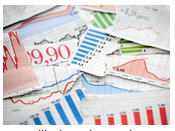 Over the weekend, I met with a friend of mine. He’s been a stock market investor for some time now, and over the last few years—especially since 2012 and 2013—he has done phenomenally well when it comes to his portfolio performance.
Over the weekend, I met with a friend of mine. He’s been a stock market investor for some time now, and over the last few years—especially since 2012 and 2013—he has done phenomenally well when it comes to his portfolio performance.
While talking to him about markets, he said something very interesting. His exact words were, “If you are investing in the stock market using fundamental or technical analysis these days, you are most likely going to lose money—or your returns will be dismal. The basic principles of investing hardly apply these days.”
“Hold on; what?” I said.
He explained: “Between 2009 and 2011, you could have found some opportunities in the stock market, and there was still value available. After the summer of 2012, it all changed. The stock market is now dictated by financial engineering.”
He went on to say, “Don’t just take what I say; see for yourself as well. Look at the stock performance of the companies that are buying back their shares. Look at the companies that are increasing their dividends. You will see their stock value has risen significantly despite very minute changes in their fundamentals in the last couple of years. If their chart was forming a bearish pattern and you traded accordingly, you probably incurred a loss.”
He is right!
Since the summer of 2012, the stock market has risen significantly. If you look at key stock indices like the S&P 500, its return since June 2012 to the end of 2013 was almost 36%. This means that if you invested $1,000 in the stock market on June 1, 2012 and closed your position at the end of 2013, your portfolio would be worth $1,360.
If you bought companies that were buying back their shares, your return would be almost twice as much compared to the stock market. Look at the chart below of PowerShares Buyback Achievers (NYSEArca/PKW)—an exchange-traded fund (ETF) that tracks the performance of companies on the stock market that have reduced their outstanding shares count by at least five percent in the last 12 months. (Source: “PKW Profile,” Yahoo! Finance web site, last accessed April 1, 2014.)
Over the same period, whereas the overall stock market has increased by 35%, this ETF has increased by almost 61%. This means that if you invested $1,000 in June 2012, at the end of 2013, you would have had $1,610.
Will this be the trade going forward?
This can potentially remain for a long period of time. We see companies on the stock market have a significant amount of cash. They may continue to use it to buy back shares and pay higher dividends.
Investors looking to get into this trade by using ETFs like the one mentioned above have to keep in mind that if companies on the stock market continue to buy back their shares and pay higher dividends, it means their cash isn’t being used effectively—that is, it isn’t being used on other projects. This creates a long-term problem and becomes a hurdle in earning more revenue.
By Moe Zulfiqar